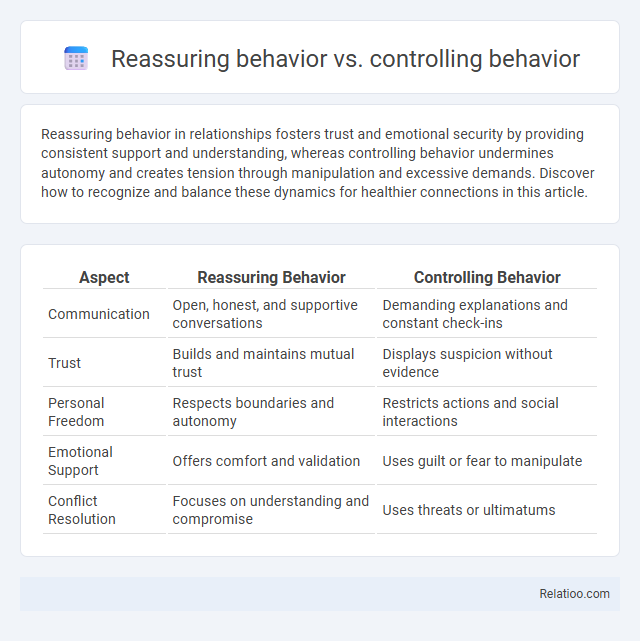Reassuring behavior in relationships fosters trust and emotional security by providing consistent support and understanding, whereas controlling behavior undermines autonomy and creates tension through manipulation and excessive demands. Discover how to recognize and balance these dynamics for healthier connections in this article.
Table of Comparison
| Aspect | Reassuring Behavior | Controlling Behavior |
|---|---|---|
| Communication | Open, honest, and supportive conversations | Demanding explanations and constant check-ins |
| Trust | Builds and maintains mutual trust | Displays suspicion without evidence |
| Personal Freedom | Respects boundaries and autonomy | Restricts actions and social interactions |
| Emotional Support | Offers comfort and validation | Uses guilt or fear to manipulate |
| Conflict Resolution | Focuses on understanding and compromise | Uses threats or ultimatums |
Understanding Reassuring Behavior
Reassuring behavior involves offering support and comfort to alleviate anxiety, fostering trust and emotional safety in relationships. Unlike controlling behavior that seeks to dominate or manipulate, reassuring behavior respects your autonomy while providing encouragement and positive reinforcement. Understanding these differences helps you build healthier interactions based on empathy rather than control.
Defining Controlling Behavior
Controlling behavior involves dominating or manipulating others to maintain power and restrict their freedom, often leading to unhealthy relationships. You may experience controlling behavior when someone imposes strict rules, monitors your actions excessively, or dismisses your feelings to assert authority. In contrast, reassuring behavior supports trust and emotional security without infringing on personal autonomy.
Key Differences Between Reassuring and Controlling Actions
Reassuring behavior involves offering support, empathy, and positive affirmations that help reduce anxiety and build trust, whereas controlling behavior seeks to dominate or manipulate outcomes through demands or restrictions. You can identify key differences by noting that reassuring actions encourage autonomy and confidence, while controlling actions undermine independence and create tension. Recognizing these patterns improves your ability to foster healthy communication and relationships.
Psychological Roots of Reassurance
Reassuring behavior stems from a psychological need to alleviate anxiety and foster security, often rooted in attachment theories where individuals seek comfort and validation to manage uncertainty. Controlling behavior arises from a deep-seated fear of losing control or feeling powerless, typically linked to insecurity and low self-esteem. While both behaviors aim to reduce stress, reassurance promotes trust and emotional safety, whereas control can undermine autonomy and heighten tension.
Motivations Behind Controlling Behavior
Controlling behavior stems from fears of vulnerability and the desire to maintain power over situations or people, often driven by insecurity or anxiety about losing control. Your need for reassurance reflects a search for emotional safety, aiming to reduce uncertainty through supportive interactions rather than dominance. Understanding these motivations clarifies how controlling behavior masks deeper emotional struggles, contrasting with genuine reassuring behavior that fosters trust and emotional connection.
Identifying Signs of Reassurance in Relationships
Identifying signs of reassurance in relationships involves recognizing consistent, supportive behaviors such as active listening, genuine empathy, and positive affirmations that foster trust and emotional security. In contrast, controlling behavior manifests through manipulative actions, dominance, and attempts to restrict a partner's autonomy, which often undermine confidence and cause anxiety. Reassuring behavior promotes open communication and comfort without imposing limitations, distinguishing it clearly from controlling tendencies.
Red Flags: How Controlling Behavior Manifests
Controlling behavior often manifests as excessive monitoring, restricting freedom, and demanding constant reassurance, signaling red flags of emotional manipulation and dominance. Unlike healthy reassuring behavior that fosters trust and security, controlling actions aim to undermine autonomy by enforcing compliance and instilling fear. Recognizing these patterns is crucial for identifying toxic relationships and safeguarding personal well-being.
The Impact of Reassuring vs. Controlling on Mental Health
Reassuring behavior fosters a sense of security and reduces anxiety by providing support and validation, which positively impacts your mental health. In contrast, controlling behavior increases stress and feelings of helplessness, often leading to anxiety and depression. Understanding the balance between reassurance and control can significantly improve emotional well-being and resilience.
Strategies to Promote Healthy Reassurance
Promoting healthy reassurance involves clear, consistent communication and setting boundaries to differentiate it from controlling behavior, which often seeks to limit autonomy and increase dependency. Encouraging open dialogue and validating emotions help individuals feel supported without fostering excessive reliance or anxiety. Implementing strategies like active listening, providing factual information, and fostering self-efficacy enhances reassurance while preventing manipulative or controlling tendencies.
Setting Boundaries to Prevent Controlling Dynamics
Setting boundaries is essential to differentiate reassuring behavior, which fosters trust and emotional safety, from controlling behavior that undermines autonomy and breeds resentment. Clear, consistent limits help reassure partners by respecting their independence while preventing controlling tendencies that often escalate into manipulation or coercion. Prioritizing assertive communication and mutual respect establishes a healthy dynamic where support does not infringe on personal freedom.

Infographic: Reassuring behavior vs Controlling behavior
 relatioo.com
relatioo.com